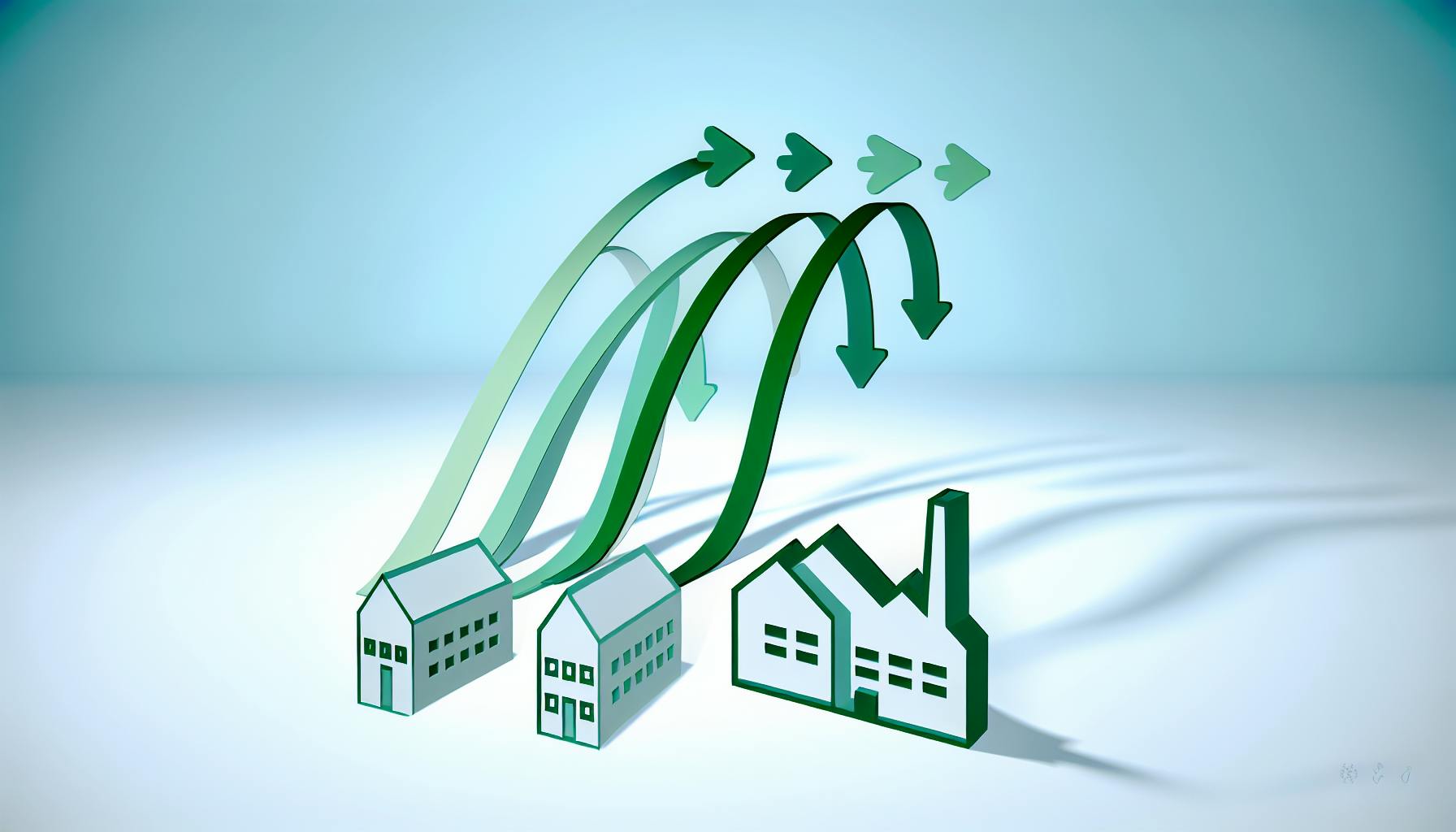Measuring carbon emissions can seem daunting for small and medium enterprises (SMEs).
However, by understanding the key concepts around carbon measurement - namely the differences between Scope 1, 2, and 3 emissions - SMEs can gain clarity on their overall carbon footprint and opportunities to reduce it.
In this post, we'll explore what constitutes Scope 1, 2, and 3 emissions, best practices around measuring each category, and how SMEs specifically can leverage carbon measurement as a path towards sustainability.
The Imperative of Carbon Measurement for SMEs
Carbon emissions refer to the release of greenhouse gases like carbon dioxide and methane into the atmosphere. These emissions are driving climate change by trapping heat in the atmosphere, leading to rising global temperatures.
As climate change accelerates, governments and stakeholders now expect companies, even small and medium-sized enterprises (SMEs), to measure, report on, and reduce their carbon emissions. Accurately tracking carbon output allows SMEs to benchmark performance, demonstrate climate leadership, and identify opportunities to lower environmental impact.
Exploring the Environmental Impact of Carbon Emissions
All business operations, from electricity usage to shipping products, result in carbon emissions that contribute to climate change. The Greenhouse Gas (GHG) Protocol provides the global standard for measuring and reporting on these emissions, categorising them into three groups called Scope 1, 2, and 3.
Scope 1 covers direct emissions from sources owned or controlled by the company, like fuel burned on-site. Scope 2 accounts for indirect emissions from purchased electricity used by the company. Scope 3 includes all other indirect emissions across the company's value chain, from raw material extraction to product disposal.
Understanding the differences between these scopes provides a comprehensive view of a company's carbon footprint. Tracking emissions then allows SMEs to benchmark performance over time and identify hotspots to target for reduction. Demonstrating climate accountability has become crucial for winning contracts, attracting investment, and maintaining a strong brand image.
Decoding Scope 1, 2, and 3 Emissions for Corporate Sustainability
Let's explore Scope 1, 2, and 3 in more detail:
Scope 1 Direct Emissions
These emissions come directly from sources within a company's control, like:
- Fuel burned for heating or transport
- HFC refrigerants that leak from AC units
- Industrial processes that release emissions
Tracking Scope 1 emissions involves monitoring fuel usage and emissions factors. This provides a baseline to compare against over time.
Scope 2 Indirect Emissions
These emissions stem from the electricity a company purchases:
- Most businesses don't generate their own power
- The emissions at the power plant end up on the company's tab
Purchased electricity makes up the majority of emissions for many SMEs (excluding Scope 3). Multiplying energy use by the utility's emissions factor derives Scope 2 emissions.
Scope 3 Value Chain Emissions
These emissions occur from assets not owned or controlled by the company across its entire value chain, including:
- Supplier extraction and production
- Transportation of goods
- Business travel
- Product disposal
Scope 3 emissions make up the majority of most companies' carbon footprints. While complex to measure, assessing Scope 3 allows SMEs to engage suppliers on sustainability efforts.
The Role of SMEs in Combating Climate Change Through Emissions Measurement
SMEs may feel measuring emissions is only for large corporations. However, climate change threatens all businesses, and stakeholders now demand climate transparency regardless of company size.
Beyond reputational benefits, accurately tracking carbon output gives SMEs data to inform strategic decisions on reducing environmental impact. From switching to renewable energy to engaging suppliers, measurement provides a roadmap to manage climate risks and capture sustainability opportunities.
The imperative is clear - SMEs must overcome perceived barriers and begin measuring emissions across Scopes 1, 2 and 3. This positions them not only as climate leaders, but also as attractive business partners prepared for a net-zero future.
How is carbon measured?
The key metric used to measure carbon emissions is tonnes of carbon dioxide equivalent (tCO2e). This standard unit allows the measurement of different greenhouse gases based on their global warming potential relative to carbon dioxide.
To measure tCO2e, companies need to conduct a greenhouse gas (GHG) inventory following methodologies like the Greenhouse Gas Protocol. This involves:
- Calculating Scope 1 emissions from owned sources like vehicles and equipment. This requires collecting data on fuel usage and emissions factors.
- Calculating Scope 2 emissions from purchased electricity. This is done by multiplying energy consumption by the emissions factor of the local electricity grid.
- Estimating Scope 3 emissions from value chain activities like employee travel, waste disposal etc. This uses spend-based calculations, activity data or supplier-specific data.
An accurate carbon measurement process requires:
- Defining organisational and operational boundaries
- Collecting extensive activity data across Scopes 1-3
- Choosing appropriate emissions factors suited to the business
- Regular verification of inventory methodology and data quality
Automated carbon accounting software can simplify this process for SMEs through:
- Data integrations to pull relevant metrics
- Embedded emissions factors customised by industry
- Flexible boundary setting aligned to different reporting needs
- Custom carbon reports that track emissions over time
With a robust GHG inventory powered by carbon measurement technology, companies can better understand their environmental impact, set science-based targets, and track progress on decarbonisation efforts.
What is the standard unit of carbon?
The standard unit used to measure carbon emissions is grams of CO2 equivalent per kilowatt-hour (gCO2eq/kWh). This allows us to quantify the carbon intensity of various energy sources.
Here's a quick overview:
- Carbon intensity refers to the amount of carbon dioxide and other greenhouse gases emitted per unit of electricity generated. It measures the climate impact of different energy sources.
- The most common metric is grams of CO2 equivalent per kilowatt-hour (gCO2eq/kWh). The "CO2 equivalent" accounts for the different global warming potentials of various greenhouse gases like methane.
- For example, in 2019 the average carbon intensity of electricity generated was 475 gCO2/kWh, a 10% improvement on the intensity from 2010. Coal has a high carbon intensity of around 1,000 gCO2eq/kWh whilst renewables like solar and wind have very low carbon intensities of around 50 gCO2eq/kWh.
By reporting carbon emissions using this standardised unit, companies can benchmark performance, set reduction targets, and compare the climate impacts of energy technologies. It brings consistency across sectors and geographies when accounting for greenhouse gas emissions.
For small and medium enterprises (SMEs) just starting their sustainability journey, understanding this basic unit empowers more informed carbon management. With the right tools, SMEs can seamlessly track their carbon footprint over time as part of their net-zero strategy.
How do you calculate carbon?
Calculating your carbon footprint can seem complicated, but breaking it down into a few key steps makes it more manageable. Here's a simplified way to get a reasonable estimate:
Understand the key sources
The main sources of carbon emissions for most individuals and small businesses are:
- Energy use - this includes electricity, gas, oil, etc. used to power your home, office, factories, vehicles, etc.
- Transportation - emissions from cars, planes, trains, etc. based on mileage/trips.
- Waste - decomposition of waste in landfills leads to methane emissions.
Tally up totals
Add up your total emissions across energy use, transportation, and other sources. There are also online carbon footprint calculators that can help compile and analyse your information.
The key is tracking your emission sources over time. This allows you to set baselines, reduction goals, and identify opportunities to lower your environmental impact. Revisiting the measurement annually provides important progress tracking.
What is the unit of measurement for carbon emissions?
The standard unit of measurement for carbon emissions is the kiloton (kt). A kiloton represents 1,000 metric tons of carbon dioxide equivalent (CO2e).
When calculating an organisation's carbon footprint, greenhouse gas emissions are converted to kt CO2e for consistent measurement and reporting. This allows the summation of different greenhouse gases, like methane and nitrous oxide, into a single unit.
There are a few key things to know about carbon measurement units:
- kt CO2e accounts for the different global warming potentials of greenhouse gases. For example, methane has a higher global warming impact per ton than carbon dioxide. Converting emissions to kt CO2e standardises the measurement.
- Carbon dioxide emissions specifically are often calculated as tonnes (metric tons) of carbon. These tonnes of elemental carbon are then converted to kt CO2e by multiplying by 3.667 - the ratio of the molecular weight of CO2 to carbon.
- Other common units for GHG emissions include tonnes (t) and million metric tons (Mt). 1 kt = 1,000 t = 0.001 Mt.
So in summary, kt CO2e allows the apples-to-apples comparison of total greenhouse gas emissions, even though individual component gases may be reported in other units. It is the standard unit for carbon accounting and footprint measurement.
sbb-itb-0f1f828
How to Measure Carbon Footprint of a Company: Scope 1 Emissions
Scope 1 emissions refer to the direct greenhouse gas (GHG) emissions that are emitted from sources owned or controlled by a company. This includes emissions from fuel combustion in boilers, furnaces, and vehicles, fugitive emissions from refrigeration and air conditioning equipment, and process emissions from chemical production or manufacturing.
For small and medium-sized enterprises (SMEs), typical Scope 1 emission sources include:
- Natural gas used for heating facilities and operating equipment
- Gasoline and diesel used in company owned vehicles and mobile equipment
- Refrigerant gases from air conditioning and refrigeration systems
- On-site landfills or wastewater treatment plants
Defining and Calculating Scope 1 Emissions
To calculate Scope 1 emissions, companies need to measure their activity data and multiply it by appropriate emissions factors:
Emissions = Activity Data x Emission Factor
For example, to calculate emissions from natural gas combustion, you would collect data on natural gas usage (in units of MMBtu or therms), and multiply it by the emissions factor for natural gas (in units of kg CO2e/MMBtu).
Emissions factors can be obtained from sources like the Gov.UK, EPA and IPCC. Using accurate, up-to-date factors is vital for precision.
Best Practices in Scope 1 Emissions Measurement
Some best practices for measuring Scope 1 emissions include:
- Track activity data (fuel use, production volumes, etc.) continuously through meter readings, purchase records, process monitors, etc.
- Maintain a rigorous inventory management system for refrigerants and other fugitive emissions sources
- Use accredited labs for fuel/waste composition analysis to derive specific emissions factors
- Consider continuous emissions monitoring systems (CEMS) for large combustion sources
- Conduct periodic leak detection and on-site audits to identify unknown emission streams
Following rigorous measurement and documentation practices is key to achieving high data quality for Scope 1.
Accurate Data Collection for Scope 1 Emissions
When collecting activity data for Scope 1 calculations, SMEs should leverage sources like:
- Utility bills for fuels like natural gas
- Fleet vehicle fuel purchase receipts
- Specifications of owned equipment and technical processes
- Engineering models or direct metering of facility/process energy flows
- Refrigerant leak inspection logs and refrigerant purchase manifests
An automated data collection and management system can help streamline this process and minimise manual error.
Accurately quantifying Scope 1 emissions provides a crucial foundation for overall carbon footprint measurement. With rigorous measurement methodologies and data gathering, SMEs can effectively track this major emissions category.
Carbon Footprint Calculator: Measuring Scope 2 Emissions
Scope 2 emissions refer to indirect greenhouse gas (GHG) emissions associated with the purchase of electricity, steam, heat, or cooling. For many companies, these emissions can represent a large portion of their overall carbon footprint. Accurately measuring Scope 2 emissions is an important step towards understanding and reducing environmental impact.
Understanding Scope 2 Emissions and Their Sources
Scope 2 emissions occur from the generation of electricity, heat, steam or cooling that is imported and consumed by a company. Common sources include:
- Purchased electricity used to power facilities and operations
- Purchased steam used for heating or industrial processes
- Purchased heat or cooling for HVAC and refrigeration
While a company does not directly emit these GHG emissions, they are responsible for the generation due to their energy consumption.
Approaches to Scope 2 Emissions Calculation
There are two primary calculation methods for Scope 2 emissions:
- Location-based: Calculates emissions based on average energy generation emission factors for the local grid where energy consumption occurs. This assesses the average carbon intensity of grids.
- Market-based: Accounts for specific emission factors from chosen energy suppliers and renewable energy certificates (RECs). This assesses emissions from chosen energy products.
Many companies take a hybrid approach using both calculations to provide the most complete view of Scope 2 impact.
Effective Data Management for Scope 2 Emissions
The essential data needed to calculate Scope 2 emissions includes:
- Energy consumption data (kWh) from utility bills and meter readings
- Emission factors for local energy grids and energy suppliers
- Purchase records for renewable energy certificates (RECs)
Robust data management processes and cloud-based software can help automate data collection and Scope 2 calculations. This provides convenience, consistency, and confidence in reported emissions over time.
Accurately measuring and reducing Scope 2 emissions is an important pillar of any comprehensive carbon reduction strategy. Choosing effective tools and approaches provides the foundation for driving meaningful progress.
Scope 3 Emissions: The Broad Spectrum of Carbon Footprint Measurement
Scope 3 emissions refer to indirect greenhouse gas emissions that occur across a company's entire value chain. Unlike Scope 1 and 2 emissions which come directly from a company's owned operations, Scope 3 emissions encompass a much broader range of activities both up and downstream. For many companies, especially SMEs, Scope 3 often represents the largest portion of their total carbon footprint.
Comprehending the Extent of Scope 3 Emissions
Scope 3 emissions can originate from a diverse array of sources, including but not limited to:
- Transportation and distribution
- Processing of sold products
- Purchased goods and services
- Waste disposal
- Transportation and distribution of purchased products
- Employee commuting
- Leased assets and franchises
- Investments
Accounting for these indirect emissions that occur across the entire supply chain is undoubtedly complex. However, given that Scope 3 emissions often represent over 80% of total emissions for SMEs, accurately measuring and reporting this category is essential for comprehensive carbon accounting.
Tackling the Challenge of Scope 3 Emissions Measurement
Calculating Scope 3 emissions poses a significant challenge compared to Scope 1 and 2 due to the expansive range of activities it encompasses outside a company's direct operations. Companies need to engage suppliers across their value chain to collect emissions data associated with materials, logistics, and other services. Lifecycle analysis of products can also derive critical carbon accounting inputs.
With such a multitude of variables spanning a company's entire value web, the collection and analysis of Scope 3 data can be a daunting task. However, standardised methodologies like the GHG Protocol Corporate Value Chain Standard provide companies with the frameworks to approach this crucial element of total carbon footprint measurement.
Data Collection Strategies for Comprehensive Scope 3 Analysis
Managing the complexity of Scope 3 emissions data requires robust processes and infrastructure for systematic collection and analysis. Strategies include:
- Supplier surveys to gather emissions data associated with materials, transportation, and services
- Product lifecycle assessments to calculate emissions from raw material extraction through end-of-life
- Automation via carbon accounting software to compile, analyse, and report aggregated Scope 3 inputs
- Data infrastructure with APIs and integrations to sync supplier data
- Ongoing stakeholder engagement across the value chain to maintain current emissions factor data
With concerted efforts to gather accurate inputs leveraging these methods, companies gain invaluable visibility into their comprehensive carbon footprint encompassing emissions across the entire product lifecycle and supply web. The payoff is multidimensional - not only achieving granular carbon accounting, but also identifying hotspots for reduction.
Carbon Footprint Measurement Companies and Technology
The Rise of Carbon Footprint Measurement Companies
Purpose-built SaaS solutions like EcoHedge provide automated carbon accounting that helps businesses consolidate measurement, reporting, and reductions. These flexible, cloud-based platforms integrate environmental data from multiple sources to calculate emissions across Scope 1, 2, and 3. Key benefits include:
- Comprehensive GHG accounting: Measure all relevant emission sources across the value chain.
- Customisable frameworks: Align with GHG Protocol, SASB, TCFD, CDP, and others.
- Automated tracking: Continuously update footprints with real-time data flows.
- Stakeholder reporting: Communicate sustainability performance through branded reports.
- Strategic advice: Receive guidance on science-based targets and decarbonisation planning.
With turnkey technology handling the heavy lifting of carbon management, SMEs can shift focus towards understanding their impacts, taking action on hotspots, and engaging stakeholders.
GHG Accounting Software: A Tool for Emissions Measurement
Applications like EcoHedge Lifecycle provide purpose-built greenhouse gas accounting to streamline measurement across emission scopes. Capabilities include:
- Data integration: Ingest various data types from enterprise systems and IoT devices.
- Calculation engine: Apply localised emissions factors to quantify carbon footprint.
- Customisation: Configure methodologies, organisational boundaries, and reporting periods.
- Visualisation: Interactive dashboards to display emissions profile.
- Forecasting: Model future emissions based on growth projections.
- Analytics: Identify top contributors and reduction opportunities.
With a dedicated solution managing carbon accounting activities, SMEs can efficiently baseline emissions, set science-based targets, and track performance over time.
Incorporating Clean Energy Technology for Real-Time Monitoring
Additional technologies like sensors and fleet trackers help fill data gaps for continuous emissions monitoring:
- Building sensors: Capture real-time energy usage data across facilities.
- Fleet telematics: Track vehicle movements and fuel consumption.
- Smart meters: Monitor electricity and gas demand patterns.
- Wearables: Gather operational insights from staff.
By tapping clean energy innovations, SMEs can move towards real-time footprint tracking rather than sporadic annual reporting. This enables quicker corrective actions and more agile sustainability management.
Conclusion: SMEs' Carbon Management and the Path to Sustainability
In closing, accurate carbon measurement is crucial for SMEs and achievable through focused data collection, calculation best practices, and technology adoption.
Summarising the Importance of Carbon Footprint Measurement
Regularly monitoring Scope 1-3 emissions allows SMEs to truly understand, benchmark, report on, and reduce their climate impact over time. By tracking emissions across all categories, companies gain visibility into the largest contributors to their footprint. This enables targeted reduction strategies. Consistent measurement also facilitates reporting and goal-setting around emissions. As stakeholders become increasingly focused on corporate sustainability, the ability to accurately measure and demonstrate progress will prove vital.
Adopting a Comprehensive Framework for Carbon Measurement
Following precise guidelines for emissions calculation supplemented by robust data and smart tools enables accurate carbon accounting. The Greenhouse Gas Protocol provides the globally recognised approach, while leveraging automated software streamlines data collection and analysis. Combining rigorous methodology with comprehensive data and technology allows SMEs to efficiently and accurately measure emissions across the value chain. This provides the foundation for science-based targets and net zero strategies.
Embracing Corporate Sustainability for Future Growth
By leveraging the right combination of disciplined internal tracking and specialised software, SMEs can implement a measurement program to position their business for sustainable growth. Taking a data-driven approach builds credibility with stakeholders and unlocks opportunities. As sustainability becomes mainstream, companies failing to measure emissions risk falling behind peers. However, those focused on comprehensive carbon accounting and reduction will strengthen resilience, realise efficiencies, and align with customer values to drive growth.



.png)


